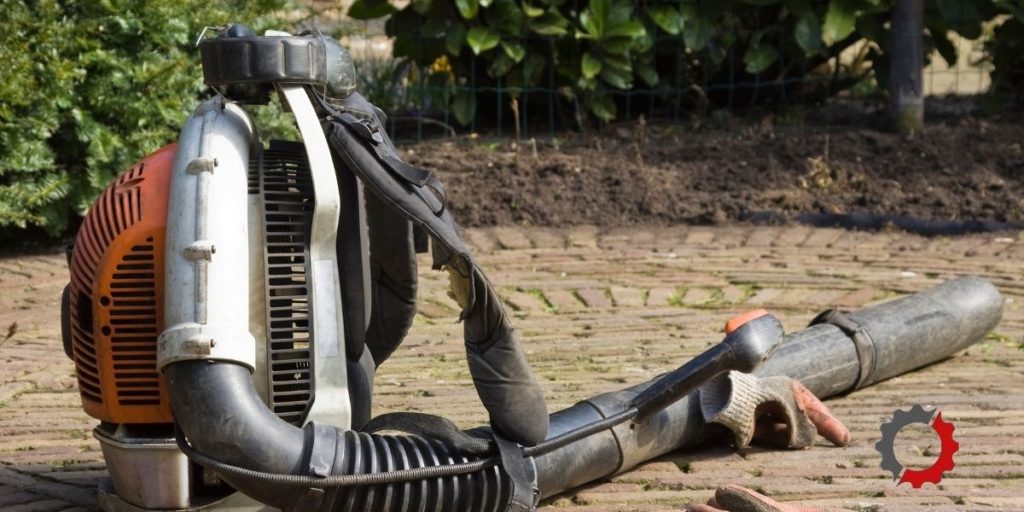Everyone knows you have to put gas in a gas-powered leaf blower to start and run it, but not everyone knows the importance of using the right gas. This is one step you don’t want to get wrong because the consequence is damaging a leaf blower beyond repair.
Leaf blowers are built with either a 2-cycle or 4-cycle engine (also known as a 2-stage and 4-stage engine). While most leaf blowers you find being used today are 2-cycle leaf blowers, you can now find blowers with 4-cycle engines being sold. Know the type of engine in your leaf blower before filling it with gas and oil.
2-cycle leaf blowers require a gas and oil mix at a ratio of 50:1, 40:1, or 32:1 which varies by manufacturer. This mix consists of unleaded gasoline with a minimum octane rating of 89 and a maximum 10% ethanol content, and a 2-cycle premium oil that is ISO-L-EGD and JASO M345 FD certified. 2-cycle leaf blowers have a single fill port for the gas and oil mix.
4-cycle leaf blowers require unleaded gasoline with a minimum octane rating of 89 and a maximum ethanol content of 10%. It has a separate fill port for engine oil. Most 4-cycle leaf blowers use a SAE30 or 10W-30 engine oil. Follow your manufacturer’s recommended oil viscosity.
Note: STIHL does offer some leaf blowers that use a 4-cycle engine, but require a gas and oil mixture at a ratio of 50:1.
Proceed with caution when adding gas and oil to your leaf blower. Wear the proper safety equipment and take all safety precautions provided in your operator’s manual.

This post may include affiliate links. Purchases made through these links may provide a commission for us, at no extra cost to you. As an Amazon Associate, we earn from qualifying purchases.
Follow all safety instructions provided in your equipment operator’s manual prior to diagnosing, repairing, or operating.Consult a professional if you don’t have the skills, or knowledge or are not in the condition to perform the repair safely.
Old Gas in a Leaf Blower
Using old gas in your leaf blower can result in starting and running problems. Old or dirty gas can clog the fuel system and damage the carburetor and engine.
Because gas will begin to break down as soon as 30 days after purchase, it’s important to consume fuel within this timeframe. If you purchased more gas than you can use within 30 days, add a fuel stabilizer to allow it to last a little longer without breaking down.
Most gasoline on the market today contains ethanol, an alternative fuel added to make fuel more environmentally friendly. Ethanol is not good for a small engine like the one on your leaf blower.
Ethanol naturally attracts moisture from the air which causes corrosion and gumming of the fuel system.
Leaf blowers require unleaded gasoline with a minimum octane rating of 89 (mid-grade) and maximum ethanol content of 10% (E10).
Never use E15, E30, or E85 in the engine as this will damage the engine and most likely void manufacturer warranties. The lower the ethanol content the better for your blower.
4-cycle engines use straight gasoline, while 2-cycle engines use a gas and oil mix. You don’t want to get this wrong or you may permanently damage your blower.
The exception is STIHL’s 4-MIX engines that they run on some of their backpack blowers. They are unlike other 4-cycle engines because they require a gas and oil mixture.
Ethanol-free fuels are always best to run in your leaf blower, but it is a more expensive fuel choice. Ethanol-free fuels can be purchased in handy canisters for both 4-cycle engines and 2-cycle engines.
The convenient option of using 2-cycle premixed fuels is that they are ready to use and you don’t have to measure and mix gas and oil.
Ethanol Free Fuels for Leaf Blowers
- 2-Cycle 50:1 Premix
- 2-Cycle 40:1 Premix
- 4-Cycle Fuel
Gas and Oil to Use in a 2-Cycle Leaf Blower
2-Cycle Gas and Oil Mix in a Leaf blower
Know the type of engine you have on your leaf blower. Don’t make the mistake of adding straight gas in a 2-cycle blower or you’ll end up having to buy a new one.
Straight gas runs very dry and will cause the engine to seize up and quit. Without oil added to the gas, the engine doesn’t get the lubrication it requires for internal parts to move freely.
A 2-cycle engine will have one fill port for an oil and gas mix. The gas-to-oil mix required is typically at a ratio of 50:1, 40:1, or 32:1. This means for a 50:1 ratio, mix 50 parts gas to 1 part oil. The ratio required varies by manufacturer.
You can find the right mix for your leaf blower listed in your operator’s manual or sometimes on the fuel cap. I have also listed the ratio for current common leaf blowers below.
When creating this mix, use unleaded gasoline with a minimum octane rating of 89 (mid-grade) and maximum ethanol content of 10%. Add a 2-cycle premium oil that is ISO-L-EGD and JASO M345 FD certified.
Most manufacturers offer their own branded oil. I also like this product offered by Kawasaki.
Here are common leaf blower manufacturers along with their current required fuel-to-oil mix ratio:
| Manufacture | Gas to Oil Mix | 2-Cycle Oil | Premixed Fuel |
|---|---|---|---|
| ECHO | 50:1 | Echo | Red Armor Pre-Mix |
| Husqvarna | 50:1 | Husqvarna | XP Pre-Mix |
| MTD | 40:1 | ||
| Poulan Pro | 40:1 | ||
| RedMax | 50:1 | RedMax | |
| Ryobi | 50:1 | Ryobi | |
| Shindaiwa | 50:1 | Shindaiwa | Red Armor Pre-Mix |
| Stihl | 50:1 | Stihl | Moto Mix Pre-Mix |
| Tanaka | 50:1 | ||
| Toro | 50:1 | Toro | |
| Weed Eater | 40:1 | ||
| Troy-Bilt | 40:1 | ||
| Yard-Man | 40:1 |
How to mix gas and oil for a 2-cycle leaf blower:
- Use the chart below to determine how much fuel mix to prepare.
- Remove the cap from an approved gas can. Add unleaded fuel (minimum 89 octane rating & maximum 10% ethanol content) to a gas can.
- Using the chart for ounces of oil required, add the 2-cycle oil to the gas can.
- Replace the cap.
- Gently shake the fuel and oil until they are mixed.
- Add to the leaf blower’s fuel tank.
You can use the manufacturer’s 2-cycle oil. Another alternative is this 2-cycle mix by Kawasaki. It comes in 5.2 oz. and 6.4 oz. bottles that can be mixed with 2 gal. or 2.5 gal. of gas respectively for a 50:1 mix. Use 2 gal. of gas and a 6.4 oz bottle of oil to achieve a 40:1 mix.
2-Cycle Gas to Oil Mix for Leaf Blowers
| Gas to Oil Mix | 1 Gallon | 2 Gallon | 2.5 Gallon |
|---|---|---|---|
| 50:1 | 2.6 oz | 5.2 oz | 6.4 oz |
| 40:1 | 3.2 oz | 6.4 oz | 8.0 oz |
| 32.1 | 4.0 oz | 8.0 oz | 10.0 oz |
Gas and Oil to Use in a 4-Cycle Leaf Blower
Gas for 4-Cycle Leaf Blower
4-cycle leaf blowers use unleaded gasoline with a minimum octane rating of 89 and a maximum ethanol content of 10%. Avoid ethanol contents greater than this. Add a fuel stabilizer like Sea Foam Motor Treatment to clean your fuel system, reduce moisture and keep it from breaking down so quickly.
The exception to this is STIHL’s 4-MIX engines. These types of 4-cycle engines require gas and oil mixed at a ratio of 50:1.
Because of the problems that can develop from using fuels with ethanol, ethanol-free fuel is best to run through your leaf blower. This is definitely more expensive than a mid-grade gas. It can be purchased in convenient fuel cans online or at your local hardware store.
You can also purchase ethanol-free fuel at some fuel stations. This is typically sold as REC-90 or recreational fuel. Check out pure-gas.org for fuel stations near you.
Engine Oil in a 4-Cycle Leaf Blower
4-cycle engines have separate fill ports for the engine oil and the fuel. DO NOT mix the oil and fuel together in a 4-cycle engine. Never use 2-cycle oil in a 4-cycle leaf blower.
Oil is required to keep the engine components lubricated. When the wrong type or not enough oil is used, friction can build in the engine and overheat causing your leaf blower not to start and possibly ruin the engine.
The engine oil viscosity may need to be changed to one better suited for very hot or very cold ambient temperatures when you are using your leaf blower in these types of conditions.
4-Cycle Manufacture and Engine Oil Viscosity
| Manufacturer | Engine Oil |
|---|---|
| Craftsman | SAE30 |
| Honda | 10W-30 |
| Makita | 10W-30 |
| Ryobi | 20W-50 (Recommended), SAE30, 10W-30, 10W-40 |
| Troy-Bilt | SAE30 |
